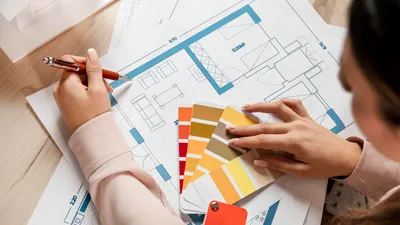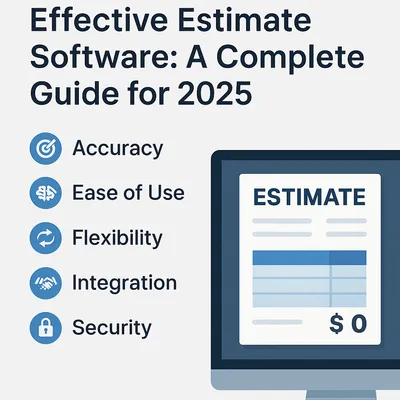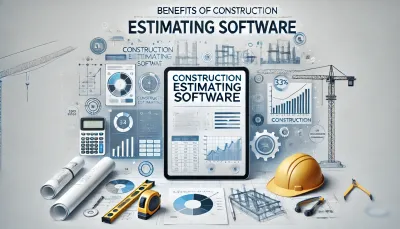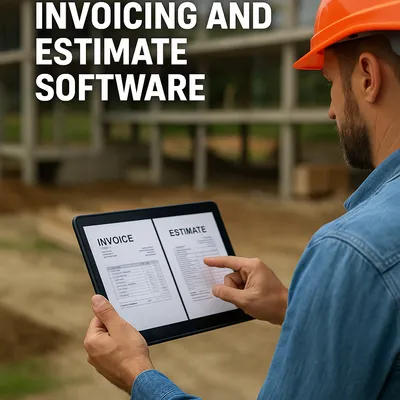How to Price Drywall Jobs: A Contractor’s Guide to Profits
Learn how to price drywall jobs accurately. Discover cost factors, labor rates, and profit margins to create competitive bids and maximize your earnings.
by
Gustavo Ferreyra • 3/10/2025
How to Price Drywall Jobs: A Contractor’s Step-by-Step Guide to Higher Profits
Did you know that labor costs eat up 60-70% of your total drywall job revenue? That’s a significant chunk that can make or break your profitability when pricing drywall jobs.
Consider this: While material costs typically range from $0.24 to $0.70 per square foot, the real challenge lies in accurately estimating labor, which adds another $1.50 to $3 per square foot. Still, many contractors struggle with drywall estimating, often missing crucial cost factors that chip away at their target 15-20% profit margin.
Whether bidding on a small room renovation or a 2,000-square-foot project requiring 55 sheets of drywall, getting your pricing right is crucial for business success. This comprehensive guide will walk through proven strategies to accurately price drywall jobs, ensure competitive bids, and maintain healthy profit margins.
Understanding Drywall Job Costs
Successful drywall pricing starts with a thorough understanding of three core cost components: materials, labor, and hidden expenses. Breaking down these elements helps contractors create accurate estimates and maintain profitable margins.
Material costs breakdown
The foundation of any drywall job begins with calculating material expenses. Standard drywall sheets typically cost between $0.24 and $0.70 per square foot. Furthermore, specialized materials like moisture-resistant or fire-resistant drywall range from $0.40 upward, subsequently soundproof drywall commands premium prices of $0.95 to $2.25 per square foot.
Basic materials include:
- Drywall sheets (4x8 feet, covering 32 square feet)
- Joint compound (mud): $15 to $30 per bucket
- Joint tape: $3 to $5 per roll
- Drywall screws and nails: $5 to $10 per box
Labor cost factors
Labor represents approximately 70% of total drywall installation costs. Professional installation rates generally fall between $1.50 and $3.00 per square foot. Several factors influence these rates:
Project complexity significantly impacts labor costs. Installing new drywall differs substantially from repair work, particularly because repairs require additional skill to blend seamlessly with existing walls. Additionally, finishing work varies across six distinct levels, each demanding different time investments and expertise.
The geographical location plays a crucial role in determining labor rates. Areas with fewer skilled contractors often command higher installation prices. Moreover, contractors must factor overtime costs, worker skill levels, and project supervision into their labor calculations.
Hidden expenses to consider
Beyond obvious material and labor costs, numerous hidden expenses can affect project profitability. Transportation costs for delivering materials to job sites represent a significant consideration. Additionally, contractors must account for equipment expenses, including manual drywall hoists and specialized cutting tools.
Other crucial hidden costs include:
- Site preparation and cleanup
- Debris removal and disposal fees
- Permit and inspection costs
- Insurance coverage
- Equipment maintenance
- Business overhead expenses
Overhead costs encompass various operational expenses such as vehicle fuel, safety equipment, marketing, and credit card processing fees. Calculating these expenses requires dividing yearly overhead costs by annual billable hours. For instance, if yearly overhead totals $42,000 with 4,800 billable hours, the hourly overhead cost equals $8.75.
Suppliers also influence project costs significantly. Building strong relationships with suppliers can provide valuable insights into material quality and availability. Furthermore, some suppliers offer bulk purchase discounts, potentially reducing overall expenses. Nonetheless, contractors should regularly monitor material price fluctuations, particularly since gypsum building material costs have shown consistent increases.
Successful contractors maintain detailed records of all expenses, including seemingly minor costs like different sized screws, razor blades, mesh tape, and shims. These small items, though individually inexpensive, can accumulate significantly over multiple projects. Additionally, factoring in a 20% markup for material quantity helps cover inevitable waste, as perfect utilization of every sheet proves impossible.
Calculating Your Base Price
Accurate measurements form the foundation of profitable drywall pricing. A systematic approach to calculating base prices ensures contractors capture all project costs effectively.
Square footage measurement tips
Precise wall measurements directly impact project profitability. Start by measuring each wall’s height and width separately, multiplying these dimensions to determine individual wall areas. For standard residential projects with 9-foot ceilings, multiply the living area by 3.8 and add 500 square feet for garage space.
Key measurement guidelines:
- Record measurements immediately to prevent errors
- Include spaces above doors and windows
- Avoid subtracting areas for outlets initially
- Round up measurements to accommodate potential errors
For ceiling height variations, adjust calculations accordingly:
- 10-foot ceilings: multiply living area by 4.1
- 11-foot ceilings: multiply living area by 4.5
- Add 0.4 to multiplier for each additional foot in ceiling height
Material quantity estimation
Converting square footage into material requirements demands careful consideration of standard drywall sheet sizes. A 4x8-foot sheet covers 32 square feet, whereas a 4x12-foot sheet covers 48 square feet. To determine sheet quantity, divide total square footage by the coverage area of chosen sheet size.
Material estimation formula:
- Calculate total square footage
- Divide by sheet coverage (32 for 4x8 sheets)
- Add 10-15% for waste and unexpected needs
For example, a 650-square-foot project requires approximately 21 sheets of 4x8 drywall. Beyond drywall sheets, contractors must calculate quantities for:
- Joint compound for smoothing joints
- Paper or fiberglass tape for reinforcing
- Appropriate fasteners for secure installation
- Special materials based on environmental requirements
Price variations exist based on material thickness:
- 1/4-inch sheets: $10-$12 per sheet
- 3/8-inch sheets: $10-$15 per sheet
- 1/2-inch sheets: $10-$20 per sheet
- 5/8-inch sheets: $13-$75 per sheet
Installation costs fluctuate based on room dimensions. A small bathroom (100 square feet) typically costs $400-$650, whereas a large living room might range from $1,500-$3,000. These variations underscore the importance of precise measurements and material calculations.
Current market rates indicate drywall installation costs average between $2.31-$2.72 per square foot. However, final pricing should reflect local market conditions, project complexity, and specific material requirements.
For optimal estimation accuracy:
- Document all measurements systematically
- Use digital calculators to prevent mathematical errors
- Consider sheet orientation during quantity calculations
- Factor in local building code requirements
The base price calculation process requires attention to detail and consideration of multiple variables. Contractors should maintain detailed records of measurements, material quantities, and associated costs. This systematic approach helps prevent material shortages during installation while maintaining competitive pricing structures.
Remember that base price calculations serve as the foundation for final project quotes. Accurate measurements and material estimations directly impact project profitability and customer satisfaction. By following these guidelines, contractors can develop precise base prices that account for all necessary materials and installation requirements.
Setting Labor Rates
“Remember that labor usually consumes 60% to 70% of total costs -“ keep this in your thought process while constructing your pricing.” - Contractor Plus, Leading contractor management software company
Determining appropriate labor rates stands as a critical factor in securing profitable drywall projects. A well-structured pricing strategy balances competitive rates with sustainable business operations.
Hourly vs flat rate pricing
Contractors face two primary pricing models for drywall jobs. Flat-rate pricing offers a fixed cost upfront after calculating direct costs for parts, labor, and overhead expenses. This method proves effective for short-term jobs with clearly defined scopes, providing price transparency and eliminating uncertainty about variable expenses.
Conversely, hourly pricing charges based on time spent completing the job. For instance, a contractor charging $41 per hour would earn $205 for a five-hour project. This approach benefits contractors handling complex or custom jobs where project scope remains uncertain.
Each model presents distinct advantages:
Flat Rate Benefits:
- Eliminates concealed expenses
- Promotes efficient job completion
- Creates predictable revenue streams
- Simplifies customer communication
Hourly Rate Benefits:
- Minimizes risk of undercharging
- Accommodates project variability
- Reflects actual time investment
- Suits complex renovations
Worker skill level considerations
Experience levels directly impact labor rates in drywall installation. Skilled professionals demonstrate proficiency in various tasks, from accurate measurements to secure installation. These experienced workers command higher wages due to their expertise in:
- Precise sheet cutting and fitting
- Efficient project progression
- Proper stud spacing assessment
- System integration knowledge
Labor costs typically represent 60-70% of total project expenses. Professional installation rates range between $1.15 and $3.00 per square foot. This variation stems primarily from job size and finish requirements.
The installation process breaks down into specific stages with corresponding labor costs per square foot:
- Hanging drywall: $0.15 - $0.65
- Taping and mudding: $0.40 - $0.70
- Sanding and priming: $0.10 - $0.50
- Finishing: $0.50 - $1.15
Overhead cost allocation
Effective overhead allocation ensures profitability and transparent financial management. Annual overhead expenses encompass various operational costs, including equipment, permits, safety gear, vehicle maintenance, and marketing expenses.
To calculate hourly overhead costs, divide yearly overhead expenses by annual billable hours. Consider this formula:
Overhead Rate = Total Annual Overhead / Annual Billable Hours
For example, with $50,000 in yearly overhead and 4,200 billable hours, the hourly overhead cost equals $11.91. This rate helps determine project-specific overhead expenses by multiplying it by estimated project duration.
Contractors often choose between two primary methods for overhead allocation:
- Labor-only method: Applies overhead as a percentage of labor cost
- Labor-and-materials combined: Distributes overhead across both components
The labor-only method typically yields more accurate results. For instance, a company with $525,000 in overhead and $500,000 in labor costs would apply a 105% overhead rate to labor expenses. This approach provides consistent cost recovery across projects regardless of material intensity.
Proper overhead allocation supports:
- Accurate project profitability analysis
- Competitive bid preparation
- Strategic resource management
- Effective cost control measures
- Transparent financial reporting
How to Bid Drywall Jobs
“The cost of installing drywall will depend upon a number of local area factors; however, on average, the cost of drywall installation ranges from $1.60 to $1.80 per square foot (including materials).” - C. David Venture, CEO of HomeBlue, a leading home improvement platform
Crafting winning drywall bids demands meticulous attention to detail and strategic planning. A systematic approach toward bid preparation sets professional contractors apart from their competition.
Creating detailed estimates
A detailed scope of work forms the cornerstone of any successful drywall bid. This comprehensive document outlines specific tasks, deliverables, and project objectives, establishing clear expectations between contractors and clients.
Essential components of a professional drywall estimate:
- Project Overview: Brief description of job scope and objectives
- Material Specifications: Detailed breakdown of required supplies
- Labor Requirements: Time estimates for each project phase
- Cost Analysis: Itemized pricing for materials and labor
- Project Timeline: Realistic completion schedule
- Terms and Conditions: Payment terms and warranty information
Before finalizing estimates, contractors must evaluate several crucial factors. First, assess project complexity, noting custom cuts, decorative elements, or unusual layouts that demand specialized skills. Second, conduct thorough site visits to identify potential challenges and obtain precise measurements.
Site assessment considerations encompass:
- Access limitations affecting work schedules
- Space availability for equipment and materials
- Existing surface conditions
- Environmental factors impacting installation
Occupied properties present unique challenges requiring additional cost considerations. These include:
- Limited work hours based on occupant schedules
- Additional protection requirements for furniture and belongings
- Space constraints affecting workflow efficiency
- Special accommodations for pets or children
Competitive analysis tips
Maintaining competitiveness in drywall bidding requires strategic market analysis alongside accurate pricing. Establishing strong relationships with multiple suppliers ensures better pricing options and material availability. This approach helps contractors secure competitive rates without compromising quality.
Market research strategies for competitive bidding:
- Study local market rates to maintain competitive pricing
- Research material costs across multiple suppliers
- Analyze competitor pricing patterns
- Monitor regional construction trends
Professional contractors differentiate themselves through value-added services rather than solely competing on price. Quality workmanship, efficient project management, and superior customer service often justify higher rates than competitors.
Time and materials (T&M) pricing offers flexibility for complex projects. Under this approach, contractors charge an hourly labor rate plus actual material costs, providing transparency while protecting profit margins.
Bid submission best practices include:
- Responding promptly to bid requests
- Providing detailed project timelines
- Including clear payment schedules
- Outlining specific project milestones
Successful contractors maintain detailed records of past project costs, enabling more accurate future estimates. This data-driven approach helps identify profitable project types and optimal pricing strategies.
Risk mitigation strategies enhance bid competitiveness:
- Adding contingency buffers for unexpected expenses
- Documenting assumptions and exclusions clearly
- Specifying material quality standards
- Outlining change order procedures
Professional presentation distinguishes winning bids. Submitting proposals on company letterhead with comprehensive information demonstrates professionalism and instills client confidence. Furthermore, marking up plans to illustrate specific work areas helps clients visualize the proposed scope.
Contractors should secure at least three subcontractor bids for each trade required, ensuring competitive pricing while maintaining quality standards. This approach helps validate cost estimates and identifies potential savings opportunities without compromising project outcomes.
Adding Profit Margins
Profit margins serve as the cornerstone of sustainable drywall contracting businesses. Understanding industry benchmarks alongside strategic pricing adjustments ensures long-term financial success.
Industry standard margins
Specialty drywall contractors aim for profit margins between 15% to 20% after covering materials, labor, and overhead expenses. Nevertheless, recent market trends indicate construction companies have increased their markups from 20% to 30% amid rising inflation.
The construction industry follows the “10-10 rule” as a baseline:
- 10% allocated to overhead costs
- 10% designated for profit margins
Calculating profit margins involves a straightforward formula:
Net Income = Total Revenue - Material Costs - Labor Costs - Overhead Costs. Once you have your net income, you can determine your profit margin using the following formula:
Profit Margin = Net Income / Total Revenue
For more details, refer to this guide on pricing drywall jobs.
For smaller businesses, markup percentages typically range from 15% to 25%, depending on various operational factors. Established contractors often maintain lower margins per project through:
- Larger client bases
- Distributed overhead expenses
- Economies of scale
Adjusting for job complexity
Project complexity directly influences profit margins. Several factors determine appropriate markup adjustments:
- Location considerations
- Regional market conditions
- Local competition levels
- Area-specific costs
- Project scope
- Job size requirements
- Technical specifications
- Timeline constraints
- Business factors
- Company size
- Operational expenses
- Equipment investments
Markup calculations must account for soft business costs unrelated to specific projects. These expenses encompass:
- Vehicle maintenance
- Equipment depreciation
- Marketing initiatives
- Administrative costs
Experienced contractors adjust their margins based on project-specific challenges. Complex installations requiring specialized skills or additional preparation work command higher markups. Similarly, projects involving repair or preparatory work necessitate adjusted profit calculations to reflect increased complexity.
To maintain healthy margins, contractors should track expenses meticulously. This includes monitoring:
- Material waste percentages
- Labor efficiency rates
- Equipment utilization
- Transportation costs
Current market data reveals construction companies achieving gross margins of 26.96%, marking a substantial increase from pre-pandemic levels of 20.13%. Undoubtedly, rising material costs and market volatility necessitate regular margin adjustments to maintain profitability.
Profit calculations require careful consideration of both direct and indirect costs. A systematic approach toward expense tracking helps identify areas where margins can be optimized without compromising service quality. Furthermore, establishing strong supplier relationships often leads to preferential pricing, ultimately supporting higher profit margins.
Common Pricing Mistakes
Pricing drywall jobs accurately can be a challenging task, even for experienced contractors. Avoiding common pitfalls is crucial for maintaining profitability and ensuring customer satisfaction. This section delves into two significant pricing mistakes that often plague drywall contractors: underestimating time requirements and forgetting additional expenses.
Underestimating time requirements
One of the most prevalent errors in drywall pricing is misjudging the time needed to complete a project. This miscalculation can lead to financial strain and potentially damage a contractor’s reputation. Several factors contribute to time underestimation:
- Complexity misjudgment: Contractors often fail to account for the intricacies of specific projects. For instance, a job requiring extensive custom cuts or decorative elements demands more time than standard installations.
- Unrealistic productivity assumptions: Estimating labor hours based on ideal conditions without considering real-world factors can lead to significant discrepancies. While a bricklayer might be expected to lay 500 bricks per day, factoring in material handling, weather delays, and site logistics could reduce daily output to 350.
- Site-specific constraints: Each project location presents unique challenges that can impact work efficiency. Restricted access in inner-city projects, for example, necessitates constant material deliveries, forcing trades to work around shortages and delays.
- Overtime considerations: When projects fall behind schedule, extended shifts become necessary. Paying time-and-a-half or double time over multiple weeks can quickly erode profit margins.
- Skill level variations: The experience and efficiency of your workforce play a crucial role in project timelines. Skilled professionals demonstrate proficiency in various tasks, from accurate measurements to secure installation, potentially reducing overall project duration.
To mitigate these issues, contractors should:
- Conduct thorough site visits to identify potential challenges and obtain precise measurements.
- Use time tracking tools to monitor progress daily and adjust estimates for future projects.
- Factor in a buffer for unexpected delays or complications.
- Consider the skill level of available workers when estimating project duration.
Forgetting additional expenses
Another common mistake in drywall pricing is overlooking or underestimating additional expenses that can significantly impact project profitability. These often-forgotten costs include:
- Overhead allocation: Many contractors focus solely on direct costs like materials and labor, neglecting the fixed and variable expenses that keep their business running. Overhead costs encompass equipment depreciation, administrative expenses, and insurance premiums.
- Equipment and tool costs: While seemingly minor, expenses for items like different sized screws, razor blades, mesh tape, and shims can accumulate significantly over multiple projects.
- Transportation and delivery fees: The cost of transporting materials to job sites is a crucial consideration often overlooked in initial estimates.
- Waste and contingency: It’s impossible to utilize every sheet of drywall perfectly. Adding a 20% markup for material quantity helps cover inevitable waste.
- Permits and inspections: Depending on the project scope and location, obtaining necessary permits and scheduling inspections can incur additional costs.
- Insurance and compliance: Public liability, professional indemnity, and contract works insurance are essential expenses that must be factored into project pricing.
- Specialized material requirements: Projects may demand specific types of drywall, such as moisture-resistant or fire-resistant options, which come at premium prices.
- Site preparation and cleanup: Costs associated with preparing the work area and removing debris post-installation should be included in estimates.
To address these often-forgotten expenses, contractors should:
- Develop a comprehensive checklist of potential additional costs for each project.
- Regularly review and update overhead calculations to ensure accurate allocation.
- Maintain detailed records of all expenses, including seemingly minor costs, to inform future estimates.
- Consider using field service management software to streamline expense tracking and estimation processes.
By addressing these common pricing mistakes, drywall contractors can significantly improve their project profitability and overall business success. Accurate time estimation and comprehensive expense accounting are fundamental to creating competitive bids that maintain healthy profit margins.
Furthermore, contractors should remain vigilant about market trends and material price fluctuations. Recent data indicates that construction companies have increased their markups from 20% to 30% amid rising inflation. Staying informed about these changes allows contractors to adjust their pricing strategies accordingly.
Lastly, it’s crucial to remember that pricing is not a one-size-fits-all approach. Each project presents unique challenges and opportunities. By conducting thorough assessments, maintaining detailed records, and continuously refining estimation processes, contractors can develop a pricing strategy that ensures profitability while delivering value to clients.
Conclusion
Successful drywall contractors understand that profitable pricing requires mastery of multiple elements. Accurate material calculations, precise labor estimates, and thorough cost tracking create the foundation for sustainable business growth.
Above all, contractors must remain vigilant about hidden expenses while maintaining competitive rates. Detailed project documentation, regular market analysis, and strategic profit margins help avoid common pricing pitfalls that often plague drywall businesses.
Certainly, contractors who implement systematic approaches toward measurements, bidding, and profit calculations position themselves for long-term success. Their careful attention to both obvious and overlooked costs, combined with strategic markup decisions, helps secure profitable projects while delivering quality work to satisfied clients.
Therefore, drywall contractors should focus on developing comprehensive pricing strategies that account for all project variables. Through meticulous planning, accurate estimating, and proper profit allocation, contractors can build thriving businesses that consistently meet financial goals while maintaining high service standards.
Aquí tienes una versión mejorada de las FAQs en inglés, con una redacción más clara y profesional:
Frequently Asked Questions (FAQs)
1. How much should I charge for a drywall job?
The cost of drywall installation typically ranges between $1.50 and $3.00 per square foot, depending on several factors such as job size, complexity, material costs, and local market rates. To determine a profitable pricing structure, calculate your labor, materials, and overhead costs, and add a 15-20% profit margin to ensure sustainability.
2. What factors should I consider when estimating a drywall job?
When estimating a drywall project, take into account the following key factors:
- Total square footage of the project
- Material costs (drywall sheets, joint compound, tape, fasteners)
- Required labor hours and local labor rates
- Project complexity and finishing level
- Additional expenses, such as transportation, permits, or equipment rentals
- Overhead costs and profit margin to ensure a competitive yet profitable estimate
3. How do I calculate labor costs for drywall installation?
To determine labor costs:
- Set your hourly rate based on skill level and market standards.
- Estimate the total hours needed for the job.
- Multiply the hourly rate by the estimated hours to get the total labor cost.
For example, if you charge $50 per hour and anticipate 8 hours of work, your total labor cost would be $400. Labor typically accounts for 60-70% of total drywall installation expenses.
4. Should I charge an hourly rate or a flat rate for drywall jobs?
Both pricing methods have advantages:
- Flat-rate pricing offers transparency to clients and can be more profitable if you work efficiently.
- Hourly pricing is better suited for complex projects with uncertain scopes.
Many contractors combine both approaches: using flat rates for standard jobs and hourly rates for projects with unpredictable variables.
5. What are common pricing mistakes to avoid in drywall contracting?
To avoid financial pitfalls, steer clear of these common errors:
- Underestimating labor hours, leading to lower profits
- Overlooking additional expenses, such as tools, transportation, and permits
- Failing to include overhead costs, which can reduce long-term sustainability
- Not applying an adequate profit margin, which can affect business growth
- Bidding too low to win jobs, which may lead to financial losses and unsustainable pricing
For the best results, always conduct a detailed assessment of the project and factor in all possible costs before providing a quote.



























